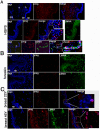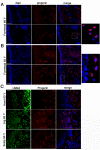The mutant form of lamin A that causes Hutchinson-Gilford progeria is a biomarker of cellular aging in human skin
- PMID: 18060063
- PMCID: PMC2092390
- DOI: 10.1371/journal.pone.0001269
The mutant form of lamin A that causes Hutchinson-Gilford progeria is a biomarker of cellular aging in human skin
Abstract
Hutchinson-Gilford progeria syndrome (HGPS, OMIM 176670) is a rare disorder characterized by accelerated aging and early death, frequently from stroke or coronary artery disease. 90% of HGPS cases carry the LMNA G608G (GGC>GGT) mutation within exon 11 of LMNA, activating a splice donor site that results in production of a dominant negative form of lamin A protein, denoted progerin. Screening 150 skin biopsies from unaffected individuals (newborn to 97 years) showed that a similar splicing event occurs in vivo at a low level in the skin at all ages. While progerin mRNA remains low, the protein accumulates in the skin with age in a subset of dermal fibroblasts and in a few terminally differentiated keratinocytes. Progerin-positive fibroblasts localize near the basement membrane and in the papillary dermis of young adult skin; however, their numbers increase and their distribution reaches the deep reticular dermis in elderly skin. Our findings demonstrate that progerin expression is a biomarker of normal cellular aging and may potentially be linked to terminal differentiation and senescence in elderly individuals.
Conflict of interest statement
Figures





References
-
- Aebi U, Cohn J, Buhle L, Gerace L. The nuclear lamina is a meshwork of intermediate-type filaments. Nature (London) 1986;323:560–564. - PubMed
-
- Hutchinson CJ, Worman HJ. A-type lamins: guardians of the soma? Nature Cell Biology. 2004;6:1062–1067. - PubMed
-
- Lin F, Worman HJ. Structural organization of the human gene (LMNB1) encoding nuclear lamin B1. Genomics. 1995;27:230–236. - PubMed
-
- Wydner KL, McNeil JA, Lin F, Worman HJ, Lawrence JB. Chromosomal assignment of human nuclear envelope protein genes LMNA, LMNB1, and LBR by fluorescence in situ hybridization. Genomics. 1996;32:474–478. - PubMed
Publication types
MeSH terms
Substances
Grants and funding
LinkOut - more resources
Full Text Sources
Other Literature Sources
Miscellaneous

